8 Plants That Look Like Lavender Plant: A Detailed Guide
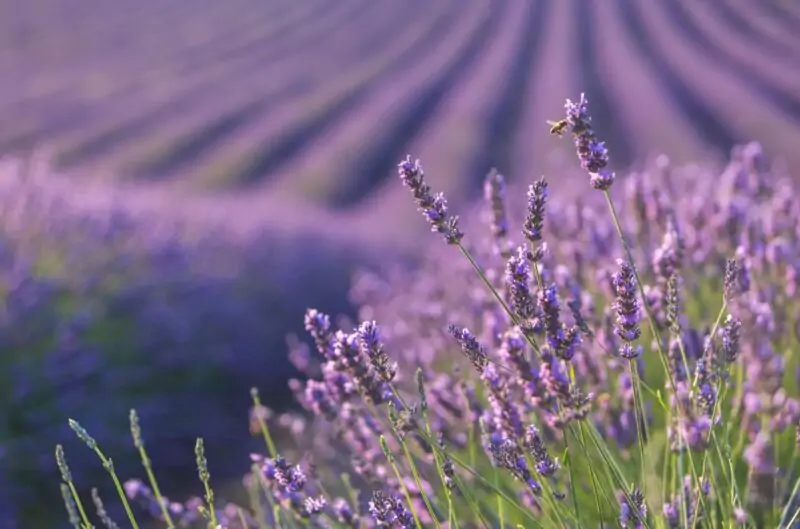
Are you looking for plants that look like lavender? Maybe lavender isn’t suitable for your area, or perhaps it’s challenging to grow in your garden. Fear not! There are many plants out there that resemble this beautiful herb and offer similar benefits. In this article, we’ll introduce eight of the best replacements for lavender.
What is Lavender Plant?
Lavandula angustifolia, aka “common” or “English” lavender, is an aromatic plant native to the Mediterranean region. This extremely well-known member of the mint family is widely cultivated all over the world because of its attractive purple to blue flower spikes and fragrant leaves.
Why Is It Popular?
People love growing lavender because it has a timeless elegance while providing various benefits such as herbal medicine properties (for anxiety), insect-repellent qualities (moths), and its heavenly scent used in aromatherapy applications.
8 Plants That Look Like Lavender: What to Expect?
While no two plants can be the exact replicas of one another, all of the eight plants described below share many similar characteristics with true lavender:
- Gorgeous blue or purple blooms
- Aromatic fragrances reminiscent of English lavenders
- Easy-to-grow varieties without needing much TLC
1. Russian Sage: Best-Known Lavender Alternative
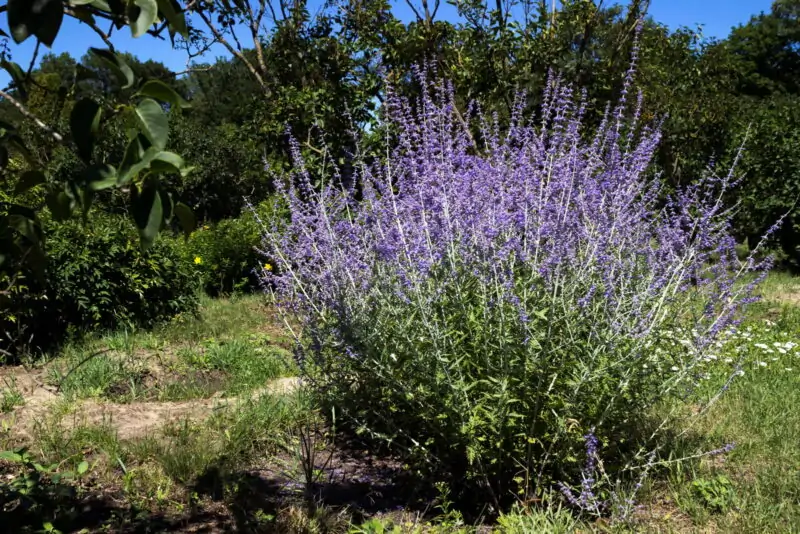
Overview & Appearance
Russian sage has lacy foliage topped with long wands filled with tiny violet-blue flowers. It is also known by another name – Perovskia atriplicifolia, which hints at its appearance.
This hardy perennial will reach around four feet tall at maturity, making it an excellent focal point in any garden due to its height!
Growing Tips & Characteristics
You can quickly establish Russian sage by starting from seeds propagated indoors before transplanting outside after the last frost date when conditions warm up enough, avoiding risks posed by sudden frost shock.
It grows best in full sun with well-drained soil, and it’s drought-tolerant once established. Russian sage has a long blooming season, starting from early summer through the first frost.
Uses & Benefits
Russian Sage makes an ideal backdrop for any garden, thanks to its height! You can also cut these flowers for indoor arrangements due to their tall wands filled with tiny blue-violet blooms that last throughout the growing season.
2. Basil: Flowering Plant Very Similar to Lavender
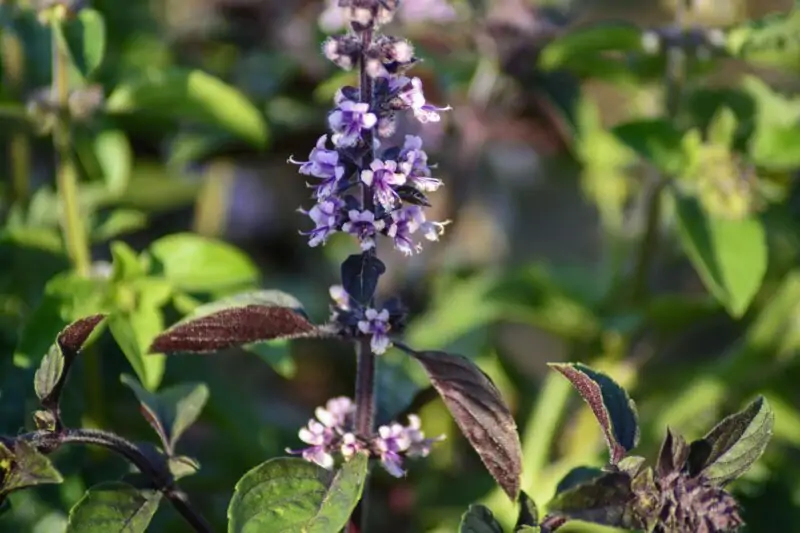
Overview & Appearance
Basil, a herbaceous plant, is primarily known for its role in Italian cuisine. However, many basil species are grown for their ornamental qualities and bear a slight resemblance to lavender.
Holy basil, which is scientifically referred to as Ocimum basilicum, shares several similar traits with lavender. Some basil varieties have leaves with purple hues or variegated patterns on green foliage and produce small white or purple flowers akin to those of English lavender.
Growing Tips & Characteristics
To grow basil, you’ll need rich, fertile soil in a sunny location (6-8 hours of direct sunlight per day), with good drainage to prevent standing water and root rot issues during periods of high humidity and temperatures above 90F degrees, which can negatively affect the plant’s flavor quality.
Basil can tolerate partial shade, but it won’t grow as vigorously compared to plants that receive six to eight hours of daily sunlight, resulting in less abundant harvests.
Basil is relatively easy to grow from seeds indoors. You can transplant it outdoors into well-prepared beds after the last frost, usually around mid-April, depending on your local weather conditions.
Uses & Benefits
Basil has various culinary uses, both fresh and dried. It is commonly added to sauces like pesto, Italian dishes such as spaghetti, pizza toppings, and garnishes for salads. Additionally, the aromatic oils produced by crushed basil leaves repel flies and mosquitoes, creating a pleasant aroma that promotes relaxation in your environment.
3. Catmint: Incredibly Beautiful!
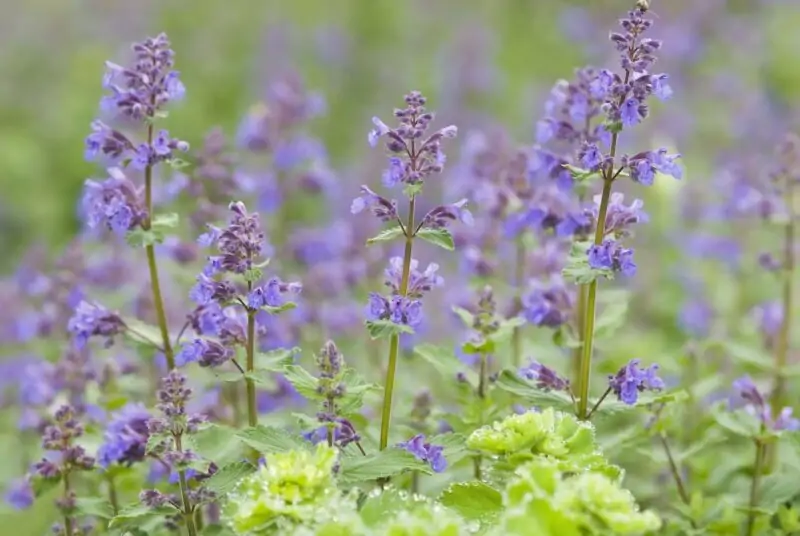
Overview and Appearance
Catmint, scientifically known as Nepeta cataria, is a hardy perennial with greyish-green leaves and lavender-blue flowers. Its long-lasting blooms attract pollinators such as butterflies and hummingbirds.
Growing Tips and Characteristics
Catmint prefers full sun but can tolerate some shade in hotter climates to avoid heat stress. It thrives in well-drained soil and grows quickly once established without spreading aggressively like other invasive plants.
Uses & Benefits
In addition to being a beautiful addition to any garden or landscape design, catmint’s aromatic fragrance repels mosquitoes while attracting beneficial insect species.
4. Rosemary: Full of Antioxidants
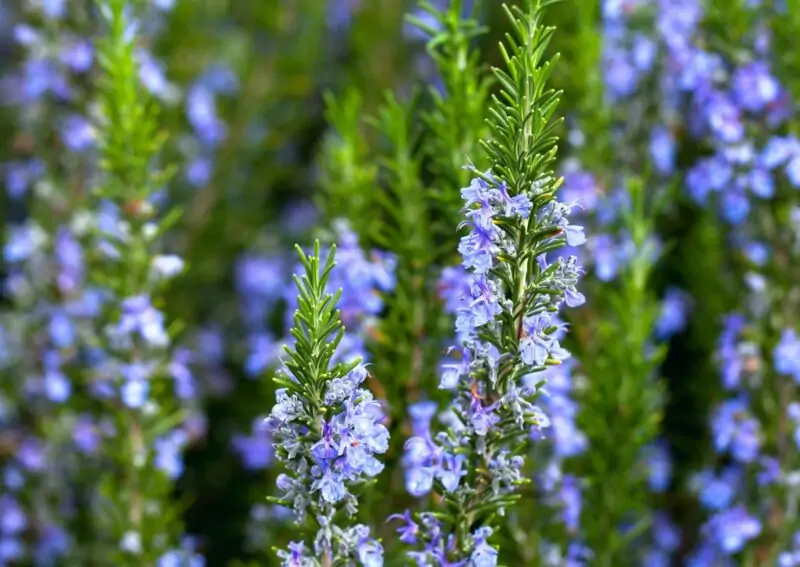
Overview & Appearance
Rosemary (Rosmarinus officinalis) is an evergreen shrub related to the mint family, producing tiny blue or purple flowers surrounded by needle-like foliage. It is drought-tolerant and can be grown outdoors year-round if protected during harsh winter conditions, such as planted near a house wall for insulation against cold snaps that could cause leaf browning or dieback.
Growing Tips & Characteristics
Rosemary requires nutrient-rich, well-draining soils in a sunny location with 5-6 hours of daily direct sunlight exposure, away from frost-prone areas since it is not frost-hardy. Employ good watering practices, allowing the topsoil layer to dry out between each cycle to avoid root rot problems caused by standing water. This plant thrives in low-humidity environments.
Regular pruning encourages new growth, leading to bushier specimens and more abundant harvests, enhancing its aesthetic appeal and culinary uses.
Uses & Benefits
Rosemary not only adds flavor to soups, stews, meats, sauces, marinades, and dressings, but it can also be infused in oil, vinegar extracts, teas, and cocktails. Freshly clipped sprigs can be used as decorations, natural air fresheners, cough suppressants, and headache relievers.
5. Purple Salvias: Lavender Looks Pale Compared to It!
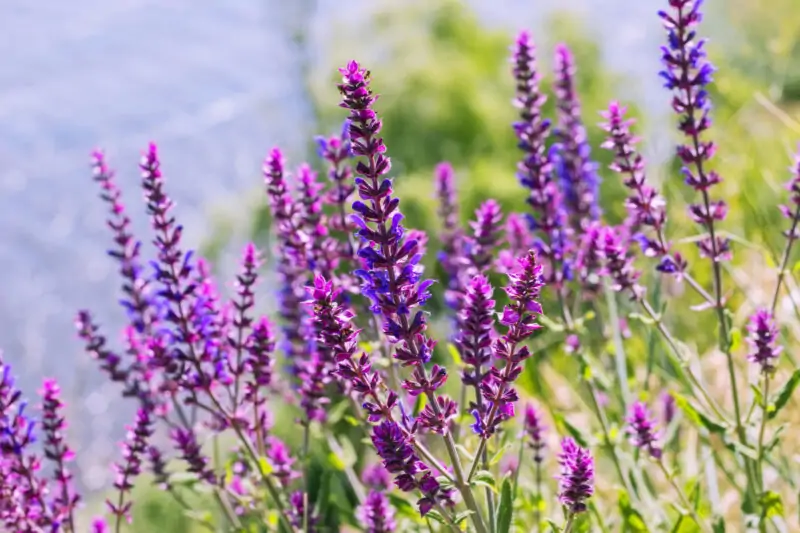
Overview And Appearance
Purple salvias are hardy perennials with long-lasting blooming seasons featuring vibrant purple flowers. Their leaves have a fragrant scent similar to lavender, making them ideal for natural air fresheners.
Growing Tips and Characteristics
Purple salvias prefer full sunlight exposure (at least six hours daily) and well-draining soil that doesn’t retain too much moisture. They’re drought-tolerant once established but do not thrive in wet conditions or heavy humidity, which can lead to fungal diseases. Pruning encourages new growth and results in bushier specimens with more abundant floral displays.
Uses & Benefits
Apart from being an excellent addition to any garden design or landscape project due to its aesthetic appeal, purple salvia’s aromatic fragrance acts as a repellent against mosquitoes while attracting beneficial insects such as hummingbirds.
6. Hyssop: Absolutely Magnificent
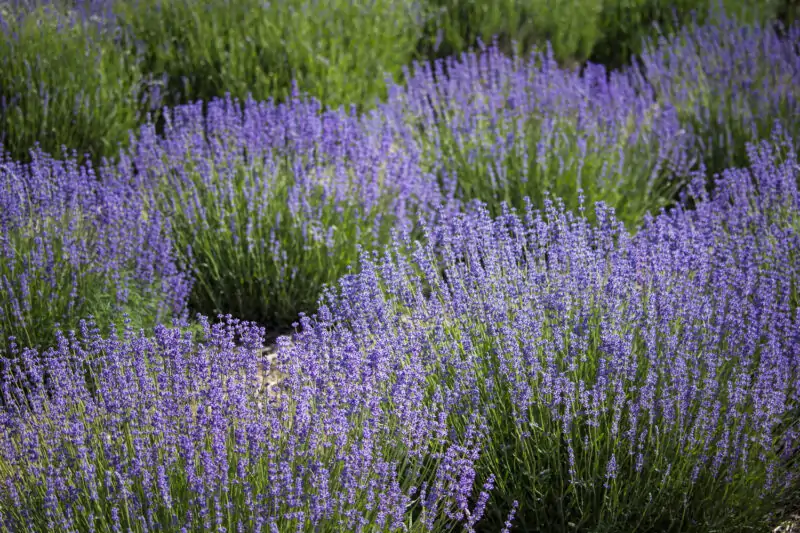
Overview And Appearance
Hyssop is an herbaceous perennial plant native to Europe, characterized by woody stems, small green foliage, and clusters of violet-blue flowers that resemble English lavender. It grows best in sunny locations, receiving at least eight hours of direct sunlight exposure daily, and thrives on dry slopes, seashores, and wind-swept plains. Hyssop prefers light, nutrient-rich loamy soils.
Growing Tips and Characteristics
Growing hyssop requires low maintenance, as it tolerates drought periods quite well. Water only when the topsoil layer dries out between each cycle, avoiding standing water underneath roots during high humidity climates prone to root rot issues. Propagate through seeds sown indoors before transplanting after the last frost date, typically around mid-April, depending on your location’s climate conditions.
Trimming promotes bushier growth, thereby maximizing flowering potential and showcasing their beauty while benefiting pollinators attracted by the blooms.
Uses & Benefits
You’ll enjoy using freshly clipped hyssop sprigs as decorations, in potpourri sachets, in herbal tea blends, and as a cooking ingredient. Hyssop is also used as a tonic and cough suppressant, and its infused oils and traditional medicine remedies treat respiratory, digestive, and urinary tract illnesses.
7. Pitcher Sage: Elegant Beyond Description
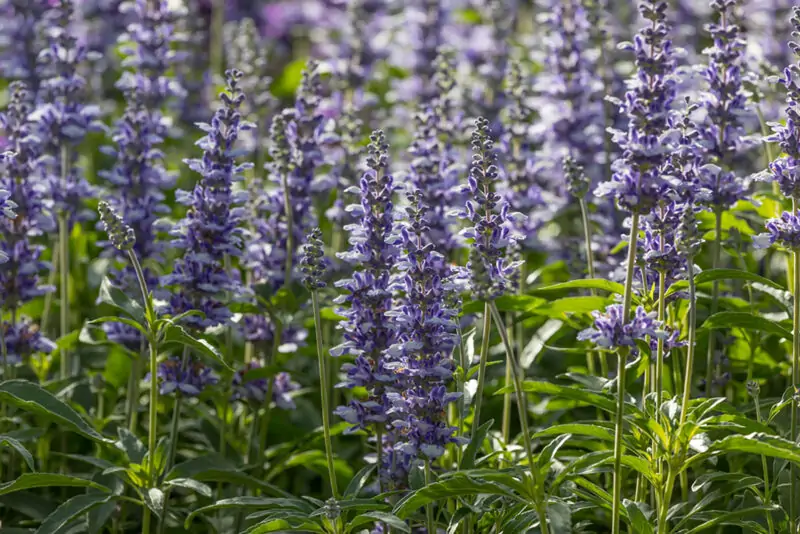
Overview And Appearance
Pitcher sage is known for its tall spikes of deep purple flowers that resemble lavender. This hardy perennial can reach up to four feet in height, making it an excellent backdrop plant or specimen.
Growing Tips and Characteristics
Growing pitcher sage requires full sun exposure and well-draining soil that doesn’t retain too much moisture. They’re drought-tolerant once established but don’t like wet conditions during high humidity climates. Pruning encourages new growth, leading to bushier specimens with more abundant blooms.
Moreover, you can propagate pitcher sage through seeds sown indoors before transplanting outside after the final frost concerns pass, typically around mid-April, depending on the region’s climate conditions.
Uses & Benefits
Pitcher sage’s aromatic fragrance acts as a natural air freshener while attracting pollinators such as bees and butterflies into gardens.
8. Wisteria: An Incredible Lavender Lookalike
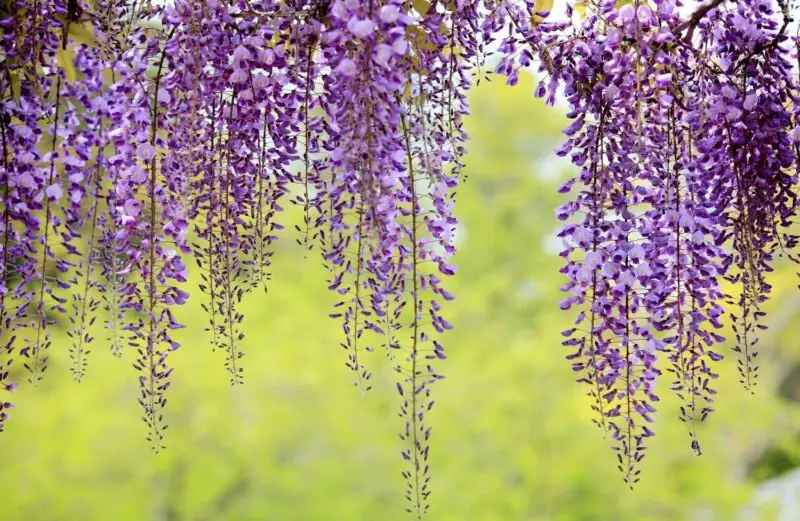
Overview And Appearance
Wisterias are vines that produce clusters of blue-violet blooms resembling English lavender. The flowers’ sweet scent attracts hummingbirds and bees while offering stunning beauty, hanging from garden arbors, trellises, and walls, cascading downwards, creating lush foliage displaying mesmerizing colors.
The mature wisteria vine reaches several meters long over time, encapsulating structures and turning them into living sculptures naturally.
Growing Tips & Characteristics
Growing wisteria requires sturdy support structures capable of holding its weight and needs to be located in a sunny area (at least six hours daily) away from frost-prone areas since they aren’t winter-hardy in zones 4-9. Pruning plays a vital role in encouraging blooming to maximize the potential display in your garden masterpiece within months.
Propagating through cuttings taken in early spring demands patience, requiring waiting until roots form and take hold inside potting mixtures. This plant enjoys moist soils rich in nutrients without becoming waterlogged, avoiding issues associated with root rot diseases.
Uses & Benefits
You’ll enjoy using freshly clipped blooms as decorations in your home or making essential oils for aromatherapy applications, all while leaving behind a beautiful fragrance around the house.
Why Grow a Plant That Looks Like Lavender Instead of the Real Thing?
Lavender is undoubtedly a beautiful plant with numerous benefits, but there are some reasons why opting for lookalike plants could be a better choice:
- Certain lookalike varietiesmay outperform true lavenders under specific conditions
- Compared to the more demanding English lavender, these alternatives are often easier to care for and maintain
- Many of these substitutes share similar appearances and fragrances, making them excellent replacements
Potential Limitations of Lavender
While lavender is a popular choice for many gardeners, it does come with some potential drawbacks. Here are a few:
- Soil Requirements: The majority of lavender varieties need well-draining soil to flourish.
- Climate: Although most lavenders grow well in warm and dry climates, they may struggle in areas with extreme heat or high humidity levels.
- Pruning needs: To maintain its structure and shape, English lavender requires regular pruning.
For those seeking the benefits of lavender with less effort, choosing an alternative plant that resembles lavender but has fewer demanding requirements might be the perfect solution.
FAQs
Here are answers to some frequently asked questions about plants that resemble lavender:
No, although Russian sage (Perovskia atriplicifolia) shares similarities with lavender, such as blue-purple flowers on tall spikes. Native to regions from Afghanistan through central Asia to China, Russian sage thrives in sunny locations with poor soils. It prefers full sun exposure and requires average watering once established, unlike English or French lavenders, which need infrequent, deep watering only when dry between 2–3 inches below the surface.
Wisterias (Wisteria spp.) might resemble certain types of pelargoniums in terms of their purple coloration. However, wisterias typically bloom later than spring-blooming lilacs, with common European species blossoming during May-June, roughly around the same timeframe when most kinds produce fresh foliage. Wisterias have twining stems that can reach heights over 30 feet and require sturdy support structures due to the weight of their heavy clusters of flowers.
Yes – both sage (Salvia spp.) and lavender (Lavandula spp.) belong to the Lamiaceae family, also known as the mint family, due to the presence of aromatic volatile oils produced by glands in their leaves and square-stemmed branches, a characteristic feature of all members of this group. Lavender and sage are generally well-adapted to Mediterranean climates, such as those in California.
When lavender starts growing from seed, it is typically small with narrow, gray-green leaves. As the plant grows larger, the leaves become more elongated, and fragrant blooms ranging from deep purple to light pink or white appear on tall stems.
Conclusion
While lavender remains a popular choice for many gardeners due to its vibrant color and aroma, there are numerous plants that look like lavender and can be used as substitutes if you’re looking for something similar but less demanding. Your choice, be it Russian sage, basil, or another plant, depends on personal preference and factors such as soil type and watering needs. Selecting an alternative lookalike plant with less demanding requirements can enable even beginning gardeners to enjoy the beauty and fragrance these lovely additions provide without the constant upkeep demands associated with true lavenders – so don’t hesitate to give them a try!